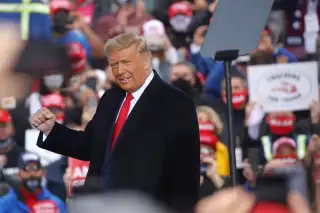How Does the Trump Economy Compare to Obama’s? A Look Back at 4 Key Data Points

When you ask Americans about the most important issues facing our country during an election cycle, you will almost certainly hear about “the economy.”
In fact, a recent report from Pew Research found that about three-quarters of all registered voters said the economy was a “very important” issue for them. A majority of voters on each side of the aisle — 66% of likely Biden voters and 84% of Trump supporters — named the economy as one of their top concerns.
Touting economic achievements is nothing new for politicians, but President Donald Trump makes it no secret he believes his administration's greatest contribution has been bringing in more wealth and prosperity for Americans. Many times, Trump has drawn stark comparisons between the successes of his own policies with those of President Obama: in February 2020, for example, Trump tweeted that the previous administration had "the WEAKEST recovery since the Great Depression."
But how can you really compare the economies under the current and previous presidencies? Some of what is construed as an economic success to certain individuals is viewed as a failure in the eyes of others, which is why measuring the strength of “the economy” under two different presidents requires an unbiased analysis of multiple different factors. In a recent report on the COVID-19 crisis, Mark Zandi, chief economist of Moody’s Analytics, broke down the differences between the economy under the last three years of Obama’s presidency and first three years under Trump. (Take note that economic data for 2020 was not included, in order to leave out the pandemonium caused by the coronavirus — and which would make Trump's numbers look worse.)
In contrast with Trump's numerous claims about building the greatest economy in history, Zandi found that by most measurements, the country's economic health under both administrations is quite similar. "The reality is that the economy did equally well in the last three years of President Obama’s second term as in Trump’s first three years," Zandi wrote.
Here’s a closer look at what the numbers say, based on Zandi's report for Moody's:
Gross Domestic Product (GDP)
When Trump took office in 2017, he promised a targeted economic growth rate of 3% each year. While the administration failed to meet that target three years in a row, Trump’s real GDP (adjusting for inflation) was still slightly higher in his first three years than in Obama’s last three. In this case, “slightly” really means just that: Annual economic output under Trump was 2.5%, compared to 2.4% under Obama.
Jobs
The last three years of President Obama’s administration saw an increase of 8.1 million jobs and a 2 percentage-point drop in the overall unemployment rate, decreasing from 6.2% in 2014 to 4.9% by the end of 2016. It's worth noting that when Obama took office in 2009, the country had recently lost around 8.6 million jobs due to the Great Recession.
Under Trump, the number of jobs increased by 6.55 million in his first three years, and unemployment dropped from 4.4% to 3.7%. At the same time, however, the growth rate of disposable income actually dropped, from 2.6% to 2.3%, according to the Moody's report. This decease is likely due in part to the rise of the gig economy; when people are working in positions like independent contractors like Uber drivers or Postmates deliverers, they typically don’t make as much per hour as they would in a position of full-time employment. This in turn lowers levels of disposable income, even as employment in general grows and unemployment rates decline. The rapid expansion of the gig economy did not begin under Trump, but his administration has seen more of its effects than previous administrations.
The Stock Market
During President Trump's first three years in office, the S&P 500 rose by 12.2%, compared to a 7.5% increase in the last three years of the Obama administration. Is this purely because investors love Trump? Maybe, but probably not.
A more likely reason, according to Zandi, is that provisions in the Tax Cuts and Jobs Act of 2017 meant large, publicly-traded corporations saw a sizable cut in the amount of taxes they had to pay in 2018 and 2019. Less taxes on corporations equals higher revenues, which in turn fuels interest in the stock market — and higher stock prices as more people look to get in on the action.
Budget Deficit
The federal budget deficit — accumulated when the government spends more than it receives in revenues — has ballooned from $15 trillion at the end of the Obama administration to over $25 trillion during Trump's first three years in the White House. Soaring deficit levels come as a natural consequence of the 2017 tax cuts: researchers at the Tax Policy Center found that corporate tax revenue declined by 40% between 2017 and 2018, while income taxes paid to the federal government declined by 5.4%. With less tax money coming in but similar levels of spending going out, it’s no wonder the federal deficit has increased.
More From Money:
2020 Finally Broke the Unemployment Safety Net. Now What?
How to Apply for Unemployment Benefits — and Get as Much Money as Possible